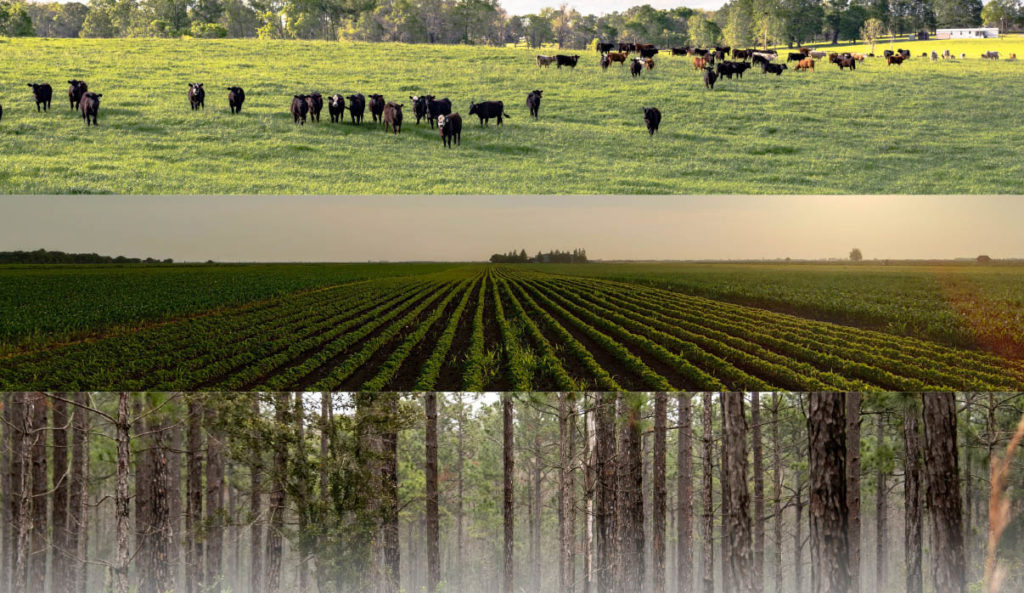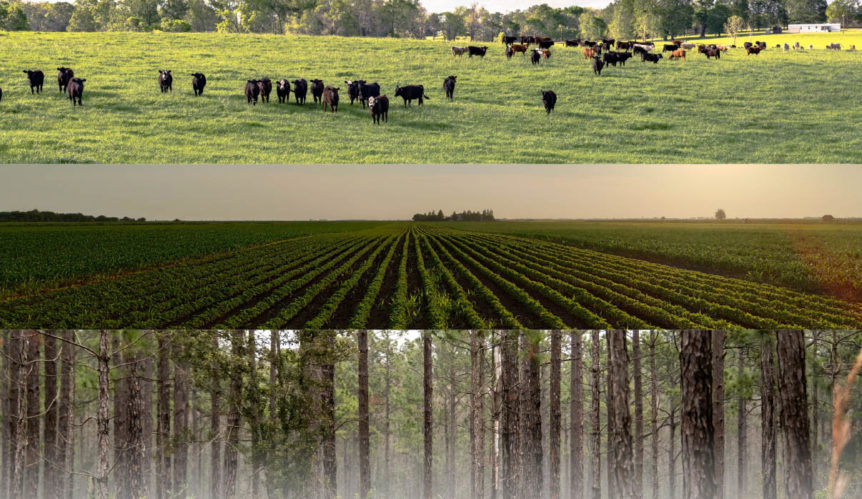
By Maegan Beatty
Competition for farmland has historically been a challenge. In places like Florida, this is especially acute as an influx of new residents puts pressure on available land for development. And in the push for green energy, green spaces are filling with huge solar farms.
The University of Florida (UF) Center for Landscape Conservation Planning provides the Agriculture 2040/2070 Report as another strong signal of the importance of preserving agriculture and green spaces. Roughly a third of Florida’s land is currently in agriculture, but urban development and, on a much smaller scale, sea level rise are projected to result in the loss of about 120 acres of agricultural land per day. That’s almost 45,000 acres per year, between now and 2070.
The loss of as much as 2.2 million acres of agricultural land over the coming decades will impact the important contributions provided by agriculture to Florida’s economy and quality of life and threaten the conservation values that many of these lands provide.
Florida Agriculture
Agriculture 2040/2070 is an analysis based on geographic information systems undertaken by the UF Center for Landscape Conservation Planning. This study focuses on the impacts of sea level rise and population growth on Florida’s agricultural lands.
Florida’s agricultural land provides essential ecosystem services, including protecting water supply and quality, providing flood control, supporting climate resilience, sequestering carbon, harboring wildlife, promoting outdoor recreation and more.
Currently, Florida has approximately 12 million acres of land dedicated to agriculture. About 41% of this land is in grazing, and 37% of this land is represented in silviculture. Other agriculture, including row crops, citrus groves, vegetables and more, represents roughly 22% of Florida’s agricultural land.
According to the University of Florida Institute of Food and Agricultural Sciences, the direct economic contributions of the agriculture, natural resource and food industries in 2019 included $106 billion in sales and 1,279,638 jobs.
Over the coming decades, Florida agriculture will start to waver due to the loss of land, which is a result of the growing population.
Report Projections
In regard to population growth, the Agriculture 2040/2070 Report shows that by 2040, there will be a 23% increase in population, with 4.9 million more residents than 2019. By 2070, there will be a 57% increase in population, with 12.2 million more residents than in 2019.
When talking about sea level rise, the report shows that by 2040, 1 million acres of land will be lost to inundation, including almost 7,500 acres of agricultural land. By 2070, 1.7 million acres will be lost, including 41,000 acres of agricultural land.
The report includes sprawl scenarios and conservation scenarios. The 2040 and 2070 sprawl scenarios reflect future development following current patterns of development. The conservation scenarios show more compact future development patterns and the avoidance of future development on priority natural land.
According to the sprawl scenario, by 2040, there will be nearly 1 million more acres of developed land, which is an increase of 17%. By 2070, there will be nearly 3.5 million more acres of developed land, which is an increase of 64%.
Compared to the sprawl scenario, the conservation scenario shows that by 2040, there will be 270,000 fewer acres of developed land, a saving of about 4%. By 2070, there will be 1.3 million fewer acres of developed land, a saving of about 14%.
Protecting Agricultural Land
Currently, almost 16% of Florida’s agricultural land has been protected through federal, state, local and private programs. State land-protection programs, including Florida Forever and the Rural and Family Lands Protection Program, are the primary funding mechanisms used for the conservation easements to protect priority natural lands throughout the state.
Michael Volk, associate director of the UF Center for Landscape Conservation Planning, highlights the importance of public policy in the protection of Florida’s land.
“Protecting Florida’s agricultural landscapes will require a coordinated effort between policy makers and landowners to maintain the food, fiber and multiple other values that these lands provide in the face of climate change and Florida’s growing population,” Volk says. “This should include identifying multiple options for both policy makers and landowners to help protect agricultural lands and production — including voluntary and incentive-based strategies and where possible, actively working with willing sellers to protect land through easements or fee simple acquisition.”
Public Policy Recommendations
Public policy plays a major role in increasing the range of ecosystem services and the capability of agricultural land use to support the economy and food security. The UF Center for Landscape Conservation Planning recommends that state and local public policy should support:
- Robust funding at the state, federal and county levels
- Sound community planning that promotes the protection of agricultural lands and minimizes fragmentation
- Science-based decision making, including public investment in the science necessary to foster sound land management and land-use decision making
- Market-based solutions, including incentivizing the protection of ecosystem services at scale to ensure the long-term viability of agriculture and the services its land provides
“There are several ways that policy makers can support Florida’s agricultural lands. Among the most important is maintaining full funding (a minimum of $500 million per year) for the state’s primary land protection programs — the Florida Forever and the Rural and Family Lands Protection programs,” Volk says. “Sound community planning that promotes agricultural land protection at the local level is also critical, along with close partnerships between federal, state, local and non-governmental organizations (such as local land trusts) to leverage multiple sources of funding. All of this work needs to be based on the best available science to support land management and strategic land-protection decisions.”
Maegan Beatty is an AgNet Media intern.










